
| Home | Table of contents | Keys | Species list | Glossary | Image data | PDF | Cite this article | Feedback | Updates |
Identification Atlas of the Vespidae (Hymenoptera, Aculeata) of the northeastern Nearctic region
CJAI 05, February 19, 2008
doi: 10.3752/cjai.2008.05
Matthias Buck, Stephen A. Marshall, and David K.B. Cheung
Department of Environmental Biology, University of Guelph, Guelph, Ontario, Canada N1G 2W1
Next species | Previous species | Key
3. Ancistrocerus albophaleratus (de Saussure, 1855), sp. restit.
Figs A4.12; B2.15, 38; B3.11, 13, 19, 22, 24, 27, 29, 31, 33, 47, 48; C1.1–11.
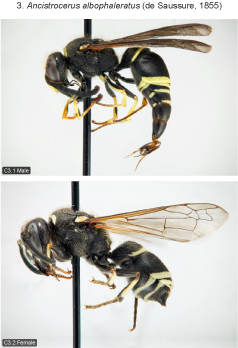 |
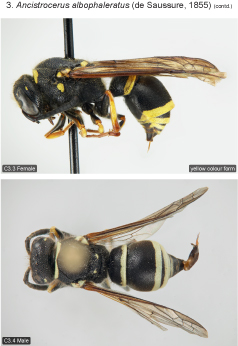 |
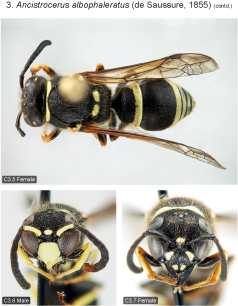 |
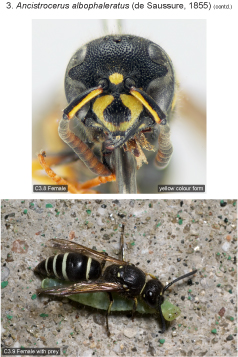 |
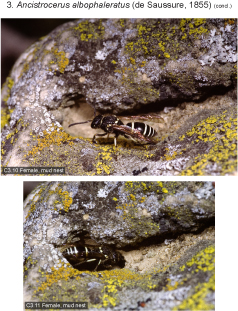 |
Taxonomy of A. catskill-complex
Species recognition. Females of most other species of the A. adiabatus-group differ from A. albophaleratus females by the presence of pale markings on the propodeum (A. catskill, A. lutonidus, rarely Ancistrocerus sp. A) or tergum 6 (A. lutonidus, A. waldenii, Ancistrocerus sp. A; exceptionally absent in all three species). Furthermore, females of A. catskill, A. adiabatus and Ancistrocerus sp. A very rarely lack the pair of ventral spots of the clypeus (absent in most A. albophaleratus, especially more northern specimens; dorsal spots often absent as well and then clypeus completely black). Both male and female of A. adiabatus have a more slender mesosoma and the female has a more flattened scutum and scutellum. Additionally the flagellum of A. adiabatus is usually extensively yellow beneath (usually dark except apically in A. albophaleratus). However, some males of A. albophaleratus with yellow body markings and yellow lower surface of the flagellum can only be separated from A. adiabatus by genitalic characters (see key). Males of other species differ by the deeply emarginate clypeus (A. waldenii) or the prominent costal scale (A. lutonidus, A. catskill, Ancistrocerus sp. A).
Variation. Fore wing length 5.0–8.0 mm (♂♂), 6.0–10.0 mm (♀♀). Pale markings of body ivory to bright yellow. In Canada the bright yellow colour form is restricted to southern Ontario and British Columbia; in the eastern U.S. it is common. Intermediate, pale yellow specimens are commonly found among males; markings of the metasoma are usually paler than those of the head. Female clypeus usually with a pair of pale dorsal spots, sometimes ventral spots also present (lateral and ventral spots very rarely confluent in ivory-marked specimens, more commonly so in yellow-marked specimens); in northern specimens clypeus frequently completely black, in rare cases only small ventral spots present. Pale spot along inner orbit of male sometimes interrupted opposite antenna or reduced to a small spot just above clypeus. Pale spot between inner orbit and antennal socket of female usually absent in ivory colour form, usually present in yellow colour form. Female scape very variably coloured: usually predominantly black with brown ventral stripe that is often reduced to a narrow posterior line or a small distal spot; in yellow-marked and a few ivory-marked specimens scape with broad yellow or ivory ventral stripe. Pedicel of male usually yellow beneath, rarely dark. Male flagellum usually only yellowish beneath on apical and basal segments, rarely dusky yellow on middle segments, in yellow colour form sometimes lower surface distinctly yellow as in A. adiabatus. Pronotal band narrow, in male the lateral portions exceptionally absent. Spot on upper mesopleuron varying from well-developed to absent in female, always absent in male. Tegula rarely without pale markings in male. Parategula black even in the most xanthic forms. Pale scutellar spots large to small in female (absent in some western specimens); present or absent and usually small in male. Metanotum almost always black, in ivory-marked females rarely, in yellow marked ones occasionally with a pair of pale spots, never with a complete transverse band. Propodeum without trace of pale markings, even in yellow colour form. Mid and hind tibiae always marked with pale; pale spot embracing dorsal midline (absent on hind tibia and attaining it only on mid tibia in 1 ♀, QC, Laniel, CNCI), in xanthic specimens of ivory colour form often entire base of tibia pale, in yellow-marked specimens tibia largely to completely yellow. Metasomal terga 1–4 or 5 fasciate in female (fascia of tergum 5 often usually abbreviated laterally; tergum 6 with pale spot in 1 ♀, ON, St. Lawrence Is. Natl. Pk., CNCI); terga 1–(4)6 fasciate in male. Female sterna 1 and 2 usually with complete apical fascia (fascia of sternum 1 often obscure or absent); fascia of sternum 2 complete (rarely interrupted in western specimens); sternum 3 usually with laterally interrupted fascia but at least lateral and small median spots present (only lateral ones present in some western specimens and 1 stylopized female from ON, Thunder Bay Distr., 25 km W jct. Hwys 11 and 802S, ROME), fascia very rarely complete in ivory colour form, usually complete or to subinterrupted laterally in yellow colour form); sternum 4 with apicolateral spots (rarely absent in western specimens), yellow-marked specimens sometimes also with more or less developed median spot; sternum 5 exceptionally with apicolateral spots in ivory colour form (1 ♀, QC, Laniel, CNCI), rarely with laterally interrupted fascia in yellow colour form. Male sternum 1 usually with more or less developed apical fascia, sternum 2 always with complete fascia; sternum 3 with complete or rarely laterally interrupted fascia; sternum 4 with apicolateral spots or interrupted fascia, rarely with complete fascia; sternum 5 black, sometimes with apicolateral and/or median spots or, rarely, apical fascia; sternum 6 black, rarely with apical fascia; pale markings of sterna 4–6 often evanescent.
Distribution. Canada: transcontinental; we have seen material from all provinces and territories except NU. Northern U.S. including AK, in mountains south to NC, NM, AZ (Krombein 1979). The distribution of A. albophaleratus in the U.S. needs to be re-examined due to confusion with related species.
Biology. Previous biological data need to be treated with caution because of confusion with other species. Ancistrocerus albophaleratus has been recorded to nest in borings in wood, hollow stems and abandoned galls using mud for nest partitions and closing plugs (Krombein 1967, 1979). Fye (1965) reared the species from trap nests; his identifications are confirmed here (material examined in CNCI). Further specimens reared from trap nests were examined by the authors (2 ♀♀, ON, Wellington Co., Morriston, DEBU). One of us (S.A.M.) observed a female at a mud nest made in the crevice of a rock near Wiarton, Bruce or Grey Co., Ontario (Figs 3.10–11). Fye (1965) recorded Tortricidae, Gelechiidae, “Noctuidae” (in the traditional sense) and Geometridae as prey. Other prey records given in Krombein (1979) (Oecophoridae, Pyralidae (Phycitinae), Pterophoridae) need to be revisited due to confusion with A. catskill.
Next species | Previous species | Key
| Home | Table of contents | Keys | Species list | Glossary | Image data | PDF | Cite this article | Feedback | Updates |
